So, you have a passion for food and a desire to share it with the world?
Starting a food blog can be a delightful journey that allows you to explore your culinary creativity, connect with like-minded individuals, and potentially even make a living doing what you love.
Whether you’re a cooking enthusiast, a foodie with a flair for storytelling, or simply someone who enjoys sharing recipes and dining experiences, this step-by-step guide will help you start your food blogging venture.
So, tie on your apron, and let’s get started!
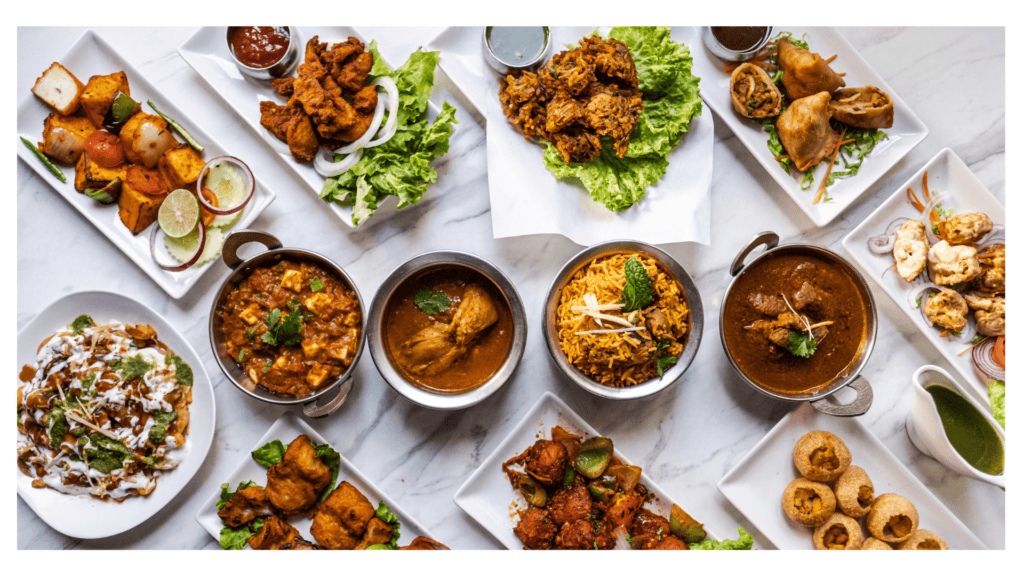
Table of Contents
ToggleFood Blogging for Beginners: Where to Begin?
Step 1# Pick your Food Niche
Finding your niche is one of the first steps to launching a successful food blog. With many food blogs already out there, discovering your unique niche is critical to standing out and connecting with your audience.
Let’s see some of the food niche ideas.
Exploring Different Food Niche Ideas
Healthy Eating and Wellness
With the rising interest in health and well-being, showcasing nutritious recipes, meal preperation tips, and wellness-focused content can attract health-conscious readers.
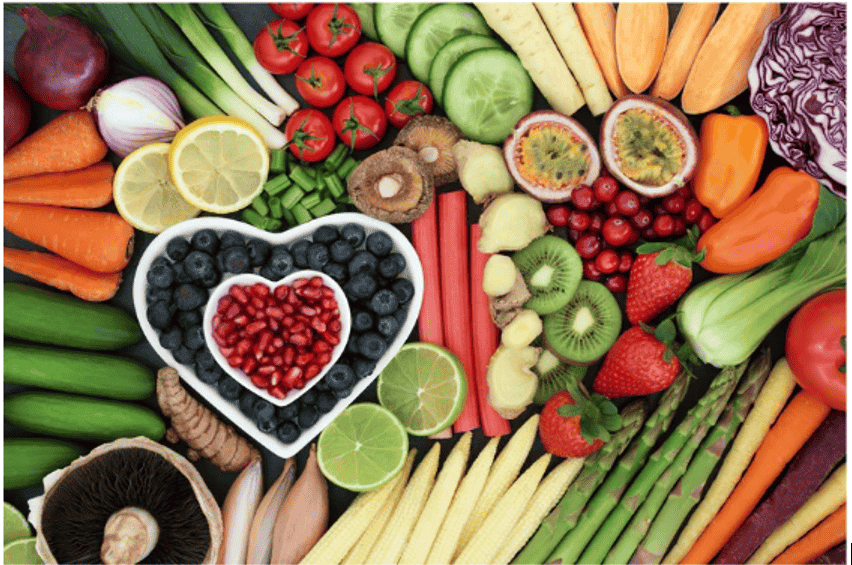
Consider exploring plant-based diets, whole foods, and mindful eating to inspire your audience to lead a healthier lifestyle.
Global Cuisine and Culinary Adventures
Explore international cuisines, traditional dishes, and cultural food traditions to take your readers on a gastronomic journey worldwide.
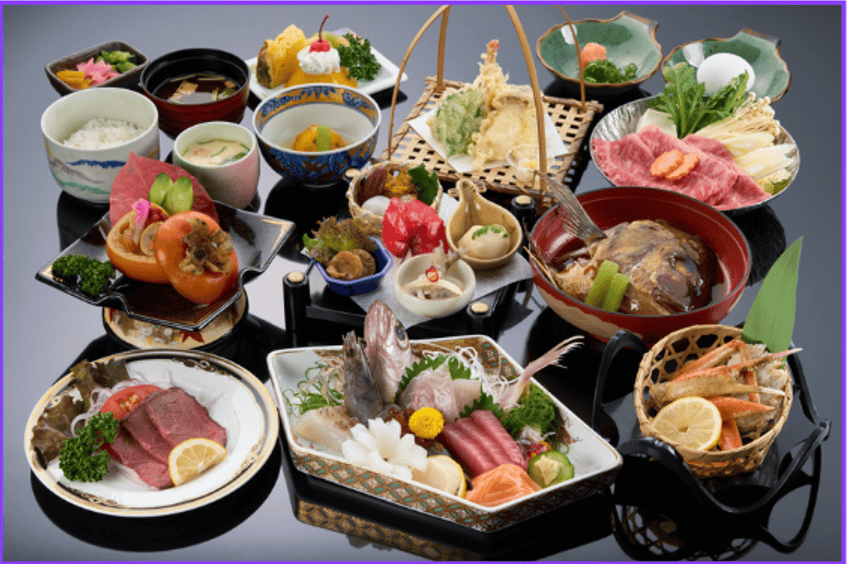
Through your blog, share your experiences with exotic ingredients, unique cooking methods, and culinary travel to transport your audience to far-off destinations.
Baking and Sweet Treats
Indulge your readers’ sweet tooth with decadent dessert recipes, baking tutorials, and pastry techniques.

Whether a novice baker or an enthusiast, showcasing your creations, from elaborate cakes to simple cookies, can create a mouthwatering and visually appealing blog that delights your audience.
Comfort Food and Family Recipes
Food is not just about sustenance; it’s also about nostalgia, memories, and emotional connections.

Share your favorite comfort food recipes, family traditions, and heartwarming stories that evoke a sense of home and togetherness.
Invite your readers to experience the comfort and joy of homemade meals through your blog.
Choosing your food niche is a personal journey that blends your culinary interests, audience preferences, and creative vision.
Remember, the most delicious food blogs are the ones that are infused with authenticity, creativity, and a generous sprinkling of love.
Happy Blogging, and Bon Appétit!
Step 2# Select a Domain Name and Buy a Hosting Plan
A strong online presence begins with selecting the right domain name and hosting plan.
Starting a food blog from scratch may seem intimidating, but it’s easier.
Choose a user-friendly platform like WordPress, Squarespace, or Blogger, pick a memorable domain name that reflects your niche, and select a visually appealing theme that appeals to food enthusiasts.
Let’s see all these one by one.
1. Select an Appropriate Domain Name
Your website name must be short and unique, easy to remember and pronounce.
Don’t use numbers or hyphens in your website address (domain name); try to include some keywords that directly reflect that your website is a food business to make it easier for the audience to connect with you.
Some examples of successful food websites are Cookie and Kate, Budget Bytes, Love & Lemons, Pinch of Yum, Minimalist Baker, Damn Delicious, Serious Eats, Spice Diary, and many more.
All have included some keywords related to food in their domain name.
Click here to check domain name availability.
The domain name is your website address.
2. Buy a Hosting Plan
Web hosting is a service that allows individuals and organizations to make their websites accessible via the World Wide Web.
It involves storing website files on powerful servers, ensuring they are secure and accessible to visitors around the clock.
When choosing a web hosting provider, key considerations include reliability, security, customer support, scalability, and pricing.
By selecting the right web hosting solution, businesses and individuals can establish a strong online presence, foster customer trust, and ensure a seamless and responsive user experience for their website visitors.
Many web hosting service providers are available, and you can buy any of them depending on your website requirements.
Let’s compare some of the best platforms so you can easily decide.
There is a difference between prominent web hosting service providers based on their features and pricing.
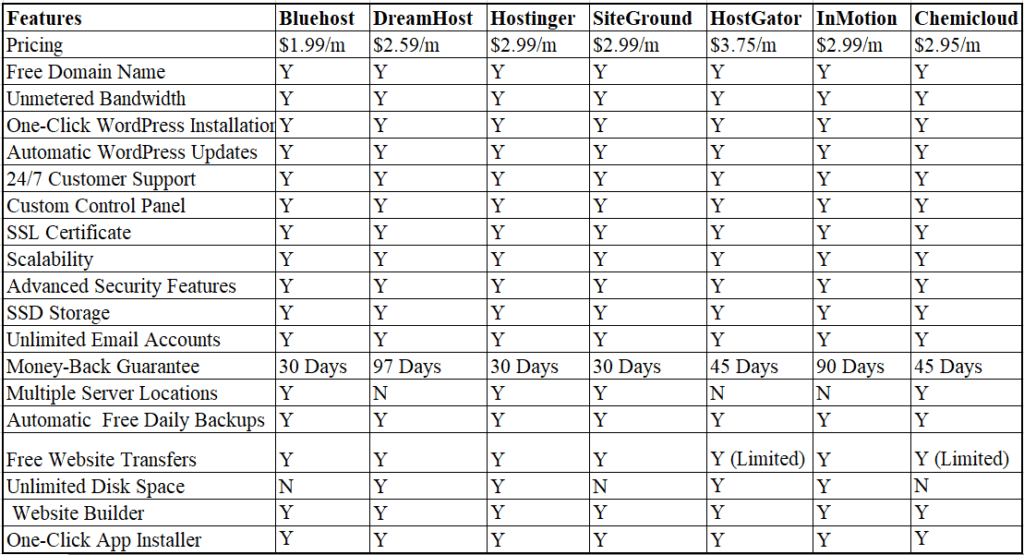
Note: Price may vary as it is subject to change based on respective company policies.
Many web hosting service providers are available but among them, Bluehost is the most budget-friendly, user-friendly, and trusted one.
Bluehost is a blogger’s recommended hosting service provider.
You must check some key points before selecting other website service providers.
Bluehost is the ideal web hosting solution for your blog.
So why not Bluehost?
Infographics on Bluehost
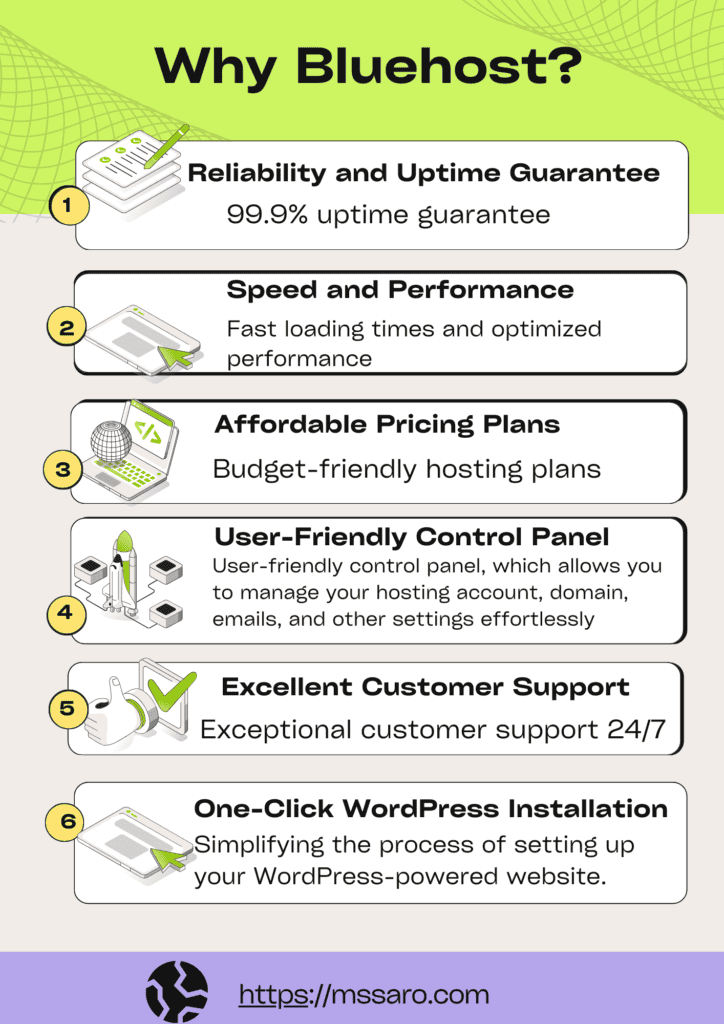
Bluehost is a top choice for bloggers seeking a reliable, affordable, and user-friendly web hosting solution.
With its focus on reliability, speed, affordability, user-friendliness, excellent customer support, and seamless WordPress integration.
Bluehost provides all the essential features and benefits to launch and maintain a successful blog.
Consider making Bluehost your hosting partner and kickstart your blogging journey with confidence.

Let’s look at the steps for buying Bluehost.
Steps for Getting Started with Bluehost Web Hosting
Step 1: Select Hosting Plan
Click the button and get started with Bluehost.
Get Started with Bluehost Hosting
Disclosure:
Please note that some links include affiliate links that have no additional cost to you; I’ll earn a little commission, which helps me create quality, well-researched content utterly free for my readers. I recommend only those products that I feel are helpful for my readers’ blogging journey.
Step 2: Select Bluehost Basic Plan
Bluehost has four plans: Basic, Choice Plus, Online Store, and Pro. Its fundamental strategy is perfect for beginners.
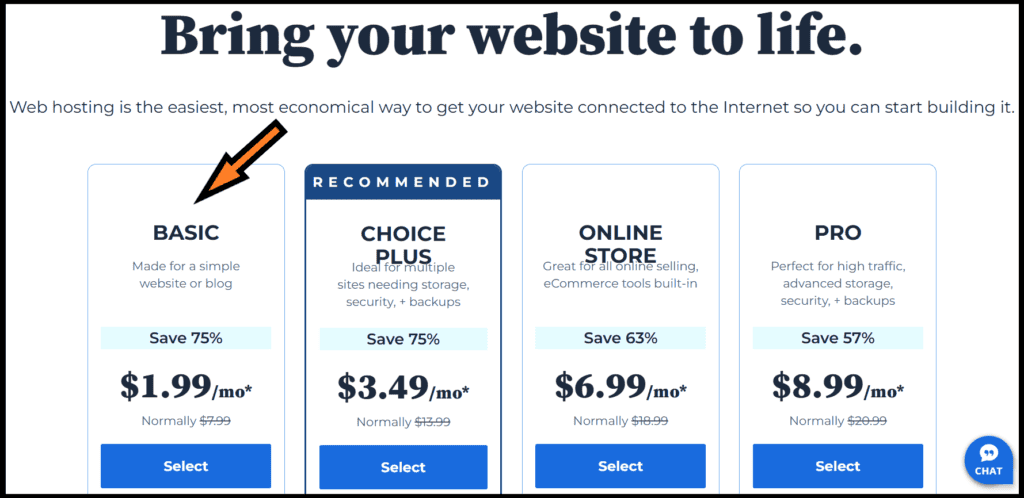
Initially, it would be best if you chose its Basic plan.
Step 3: Domain Setup page
Next, the domain setup page will appear. Here, you have to create a domain name for your website.
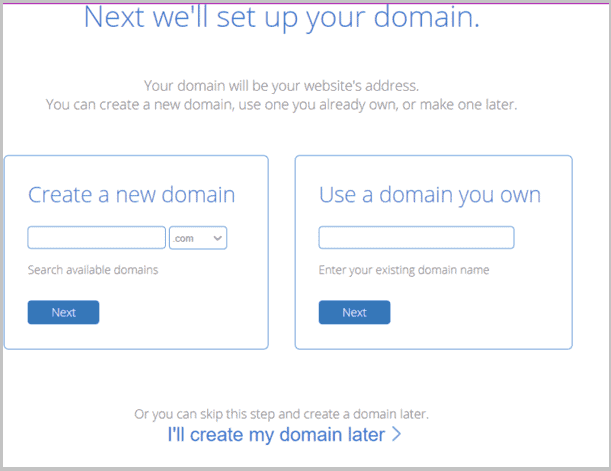
There are three options, and you can choose any of them. If you haven’t owned any domain, you can create a new domain free with Bluehost.
If you have a domain name on your website, enter the existing domain name or choose later.
Next, you must create your account by submitting the information below or using your Google account.
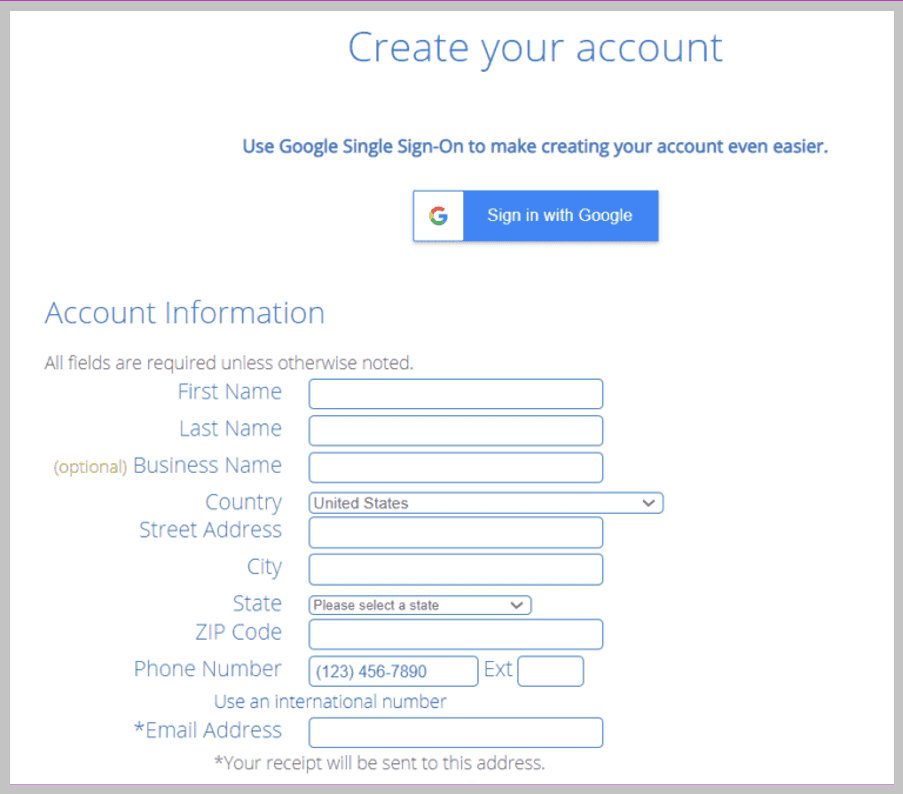
Fill in all the above information. Next, you will see package information.
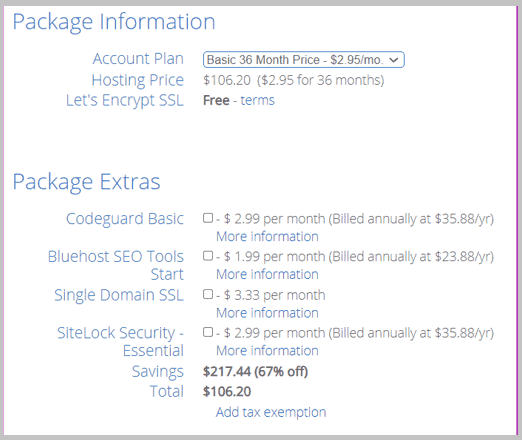
Bluehost provides extra packages you can take or go for later, per your requirements.
So, be sure to uncheck the extra package you don’t require initially so your cost of purchasing web hosting will not increase.
Next comes the payment information.
Step 4: Fill in the Payment Information Details Below
Click on the submit button. You will see your purchase was a success.
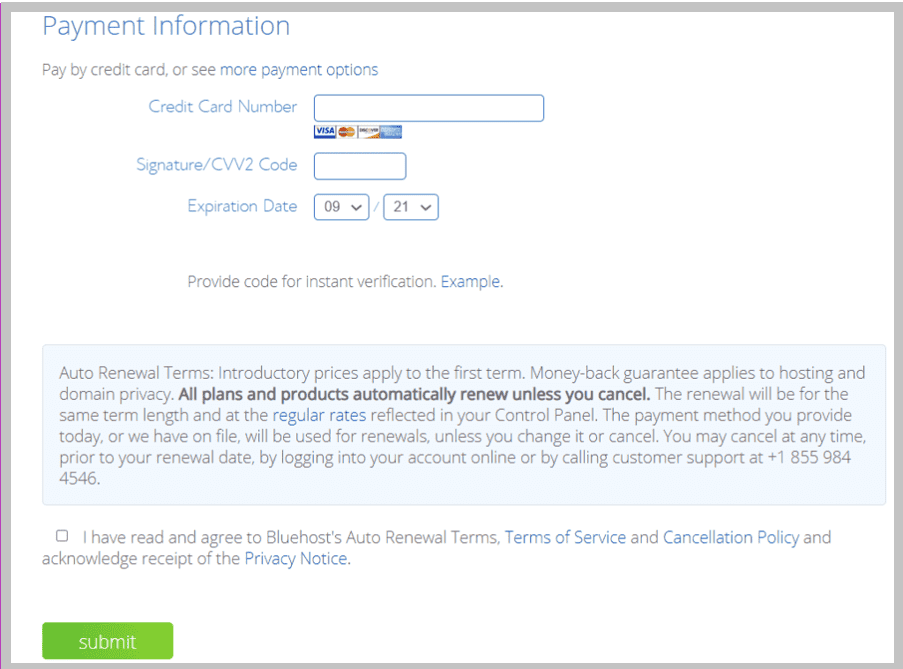
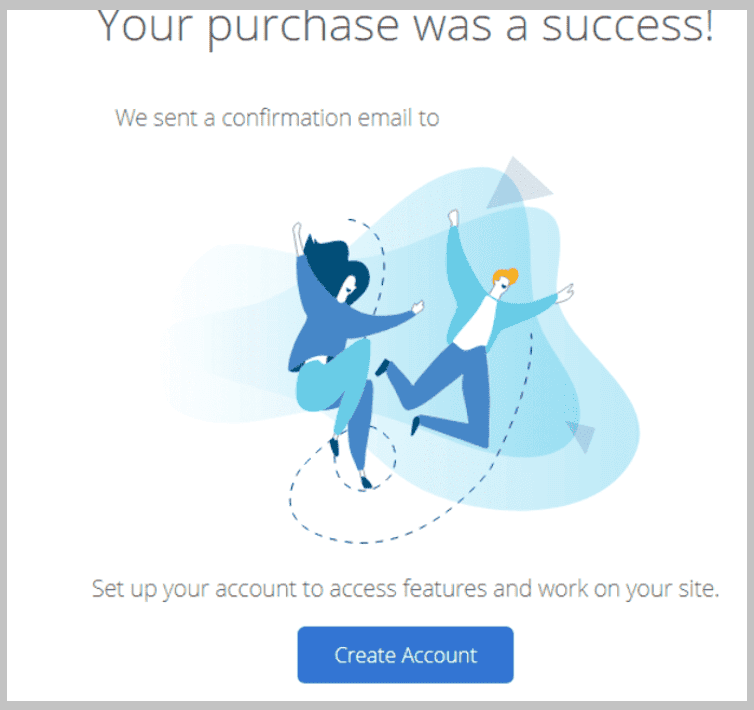
Next, you have to create a password.
Step 5: Create Password
Let’s log in to your Bluehost with your domain name/ email and password.
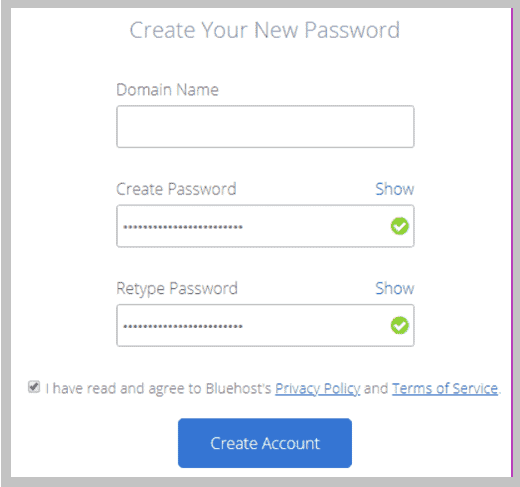
You have created your Bluehost dashboard; congratulations. Isn’t it simple?
Yes, Indeed! Simple.
Get Started and Click here to head over to Bluehost.
Step 6: WordPress Installation
Bluehost automatically installs the WordPress when you log in to your Bluehost portal.
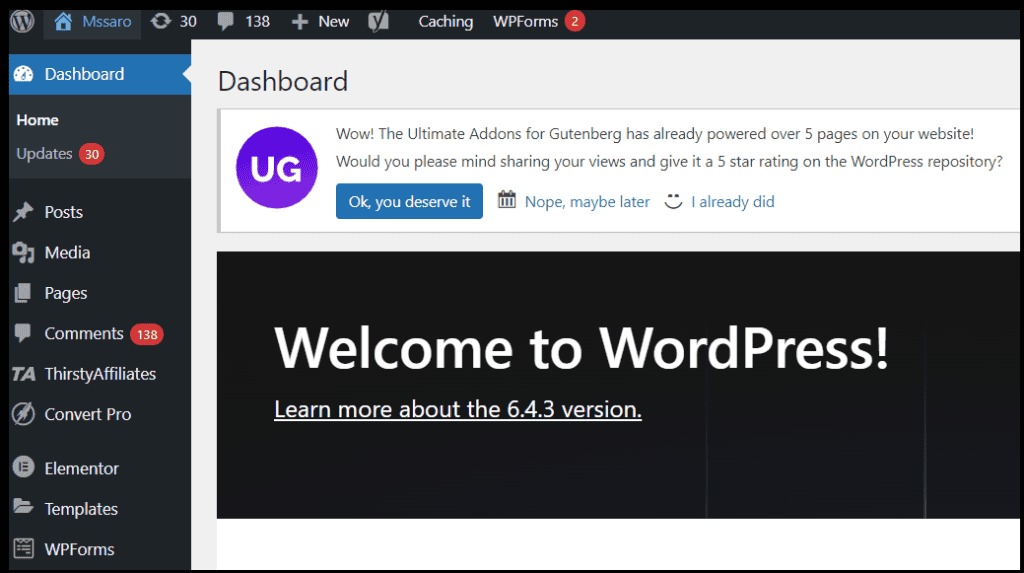
Congratulations! You can see your WordPress dashboard. Isn’t that Great?
A journey of dreams will start with your simple effort and dedication. So go for it with an open heart and start a fabulous blogging journey.
Step 3#Select Blogging Platform
Next, you have to select a blogging platform. A blogging platform is a software service or application that provides individuals with the necessary tools and features to create and manage their blogs.
These platforms typically offer templates for designing the layout and appearance of the blog, content management systems for creating and publishing posts, and options for customization.
Some notable examples of popular blogging platforms include WordPress, Blogger, Medium, Squarespace, Wix, and many others.
Almost 40% of online websites are running successfully using WordPress.
While if you are going with Bluehost, WordPress will be automatically installed.
So, you don’t have to get into its technicality. Isn’t that great?😊
Step 4# Select a Theme (Look and Feel) for your website
Creating a delicious and visually appealing website for your food blog or culinary business starts with selecting the perfect theme.
A well-designed theme enhances the aesthetics of your site and plays a crucial role in attracting and engaging your audience.
Here are some critical points in the form of infographics to consider when choosing a theme for your food website.
Infographics: Food Website Theme
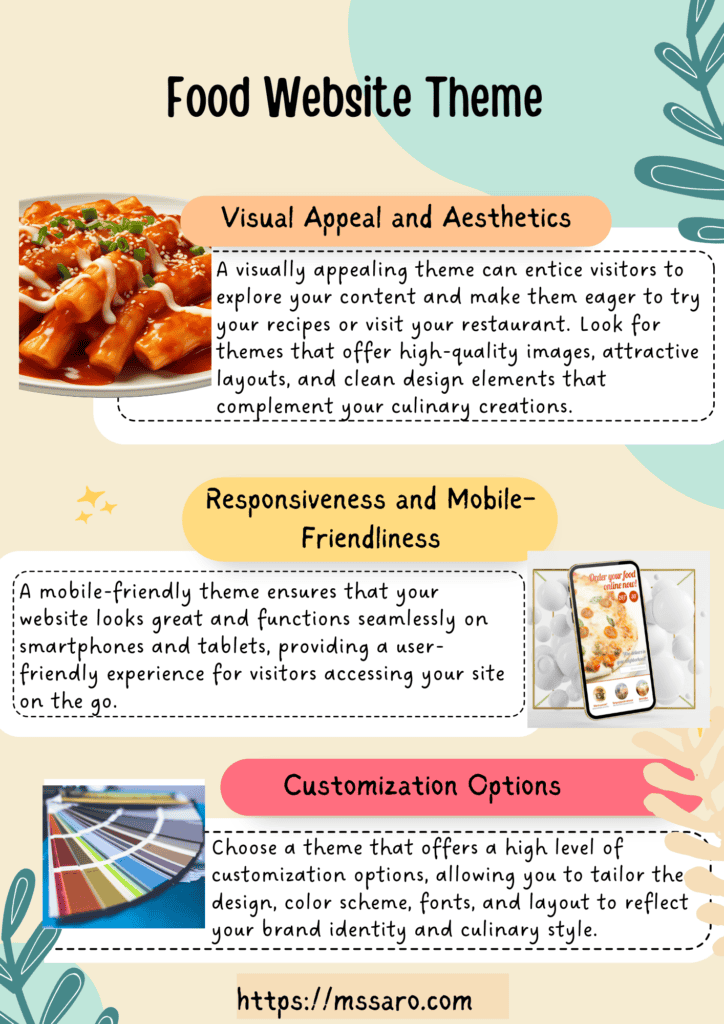
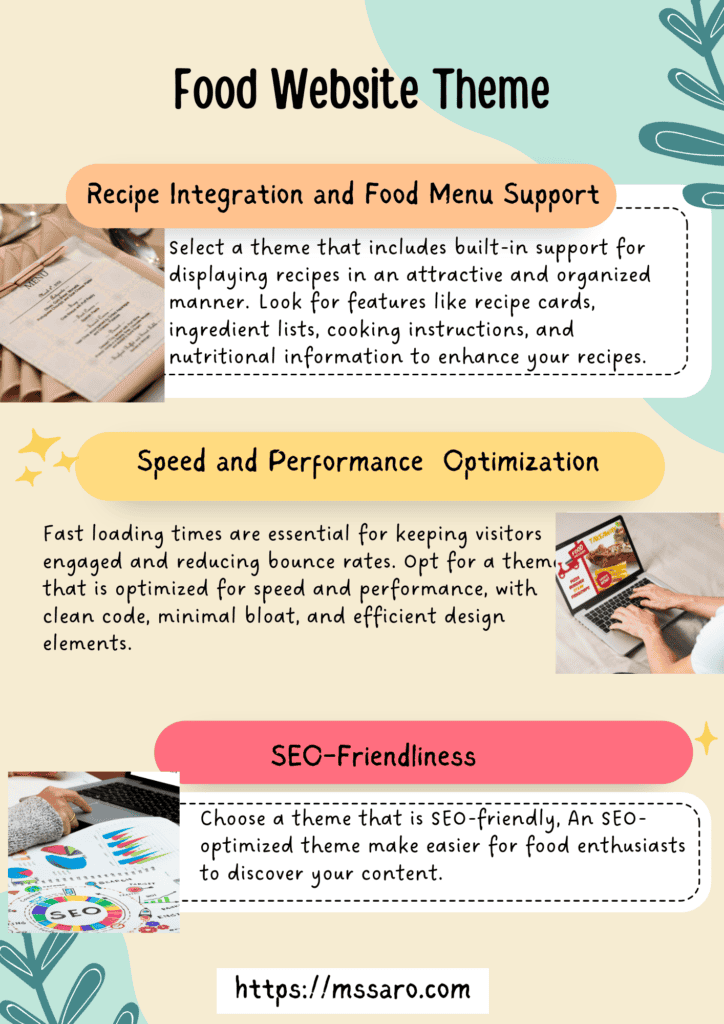
You can achieve this by carefully considering these key points and selecting a theme that aligns with your brand, style, and goals.
You can create a visually stunning, user-friendly, and engaging food website that leaves a lasting impression on your visitors.
Whether you’re a food blogger sharing your culinary adventures or a restaurant showcasing your delectable dishes, the suitable theme can elevate your online presence and set the stage for success in the digital food world.
Bon appétit!
Step 5# Write a Blog and Publish
Don’t wait. Start your blogging journey today and start writing a blog post.
Reframe it, rearrange it, and put beautiful images of your food.
Make it attractive and accessible for the reader to navigate and understand.
Conclusion
Embarking on the journey to start a food website is a delightful and rewarding endeavor.
Several key points have emerged as essential considerations for anyone venturing into culinary content creation.
Let’s reflect on the fundamental aspects of laying the foundation for a successful food website.
Essential Tips for Launching a Successful Food Blog
Here are some critical tips to help you craft engaging and mouthwatering content for your food blog:
1. Find Your Niche in the Culinary World
Before writing your food blog, consider your unique perspective and culinary passions.
Are you drawn to baking, healthy recipes, international cuisine, or vegan cooking?
Finding your niche in the culinary world will help you stand out and attract a loyal following of like-minded food enthusiasts who share your culinary interests.
Craft diverse content, including recipes, cooking tutorials, restaurant reviews, culinary travel experiences, and food-related opinion pieces.
Keep your content fresh and engaging to offer value to your audience.
2. Showcase Your Culinary Creations with Stunning Visuals
We eat with our eyes first, and this principle holds in food blogging.
Invest in high-quality photography and visually appealing images to showcase your culinary creations in the best light possible.
Capture close-up shots of your dishes, ingredients, and cooking process to visually engage and inspire your readers.
3. Food Blogger Tools and Resources
Discover essential tools and resources such as recipe plugins, food photography editing software, social media scheduling tools, and platforms for connecting with brands and fellow food bloggers.
4. Share Your Food Stories and Culinary Journey
Behind every delicious recipe lies a story waiting to be told.
Share your food stories, culinary adventures, and personal insights to connect with your audience on a deeper level.
Whether it’s a childhood memory tied to a favorite dish or a culinary mishap turned learning experience, weaving personal narratives into your food blog adds a touch of authenticity and relatability to your content.
5. Provide Value through Recipes, Tips, and How-To Guides
One of the main draws of a food blog is the wealth of culinary knowledge and inspiration it offers.
Share well-crafted recipes, cooking tips, ingredient substitutions, and how-to guides that help your readers enhance their culinary skills and knowledge.
Make your content informative, easy to follow, and actionable to empower your audience to recreate your recipes confidently.
6. Incorporate SEO Best Practices for Discoverability
Incorporate SEO best practices into your content creation process to ensure your food blog reaches a broader audience and ranks well in search engine results.
Conduct keyword research, optimize your blog post titles, headings, and meta descriptions, and focus on creating valuable, keyword-rich content that aligns with your target audience’s search intent.
Take the help of paid like Semrush or free tools like Google Keyword Planner.
7. Engage with Your Audience and Foster a Food Community
Building a thriving food blog goes beyond publishing recipes and food photos.
Engage with your audience through comments, social media interactions, and community events to foster a sense of belonging and connection among your readers.
Encourage feedback, dialogue, and shared experiences to create a vibrant and supportive food community around your blog.
8. Collaborate with Guest Bloggers, Chefs, and Influencers
Expand your reach and bring fresh perspectives to your food blog by collaborating with guest bloggers, chefs, and influencers in the culinary industry.
Take inspiration from their successes, challenges, and innovative approaches to food blogging.
Invite guest contributors to share their recipes, culinary expertise, or food-related stories on your blog.
Leverage their audience and influence to attract new readers and followers to your platform.
9. Promote Your Food Blog Across Multiple Channels
Once you’ve crafted and published your mouthwatering blog post, promote it across various channels to amplify its reach.
Share it on social media platforms, collaborate with food-related websites and publications, and participate in food-related events and collaborations to increase visibility and drive traffic to your blog.
Leverage email marketing, SEO, and other digital marketing strategies to expand your online footprint and attract a broader audience to your food blog.
10. Avoiding Common Mistakes in Food Blogging
Learn from the experiences of seasoned food bloggers by understanding the common mistakes to avoid, such as neglecting mobile optimization, overlooking the importance of food styling, or lacking consistency in content creation.
Writing and publishing a food blog is a delicious blend of creativity, passion, and culinary expertise.
By honing your writing skills, cultivating your unique culinary voice, and following the best content creation and promotion practices, you can create a mouthwatering food blog that delights and inspires your audience.
Embrace the art of food blogging, savor the flavors of online success, and invite readers to join you on a culinary journey filled with creativity, community, and culinary delights.
If you are stuck creating your dream website, comment on this post. I will try to solve your problem as we grow together. Happy Blogging!
Keep Smiling and Start Sharing!
Frequently Asked Questions (FAQ) : How to Start a Food Blogging
A. Key pages to include on a food website are the homepage, recipe index, about page, contact page, and blog or news section.
Additionally, it features individual recipe pages with detailed instructions, ingredients, and high-quality images to enhance user experience and search engine visibility.
A. To optimize your food website for search engines, focus on keyword research to identify relevant food-related keywords.
Optimize meta titles, meta descriptions, headings, and image alt text with your target keywords.
Create quality content, utilize structured data markup for recipes, and improve site speed and mobile-friendliness for better SEO performance.
A. Promote your food website through social media channels like Instagram, Pinterest, and Facebook to showcase visually appealing food images and engage with followers.
Collaborate with influencers in the food industry, participate in online communities and forums, and leverage email marketing campaigns to drive traffic and increase website visibility.
A. Monetization strategies for a food website include partnering with food-related brands for sponsored content, affiliate marketing by promoting products and earning commissions, offering cooking classes or e-books for sale, and displaying ads through platforms like Google AdSense.
Consider creating a membership site or selling merchandise to monetize your food website further.
A. Use content management systems (CMS) like WordPress to easily create and manage your food website. Invest in reliable web hosting services and security plugins to ensure website stability and protection.
Tools like Google Analytics provide insights into website traffic and performance.
At the same time, image editing software and recipe card plugins enhance visual appeal and user experience.
A. To create engaging content for your food website, focus on storytelling, personal anecdotes, and behind-the-scenes insights to connect with your audience on a deeper level.
Incorporate high-quality images, videos, and interactive elements like polls, quizzes, and user-generated content.
Encourage user engagement through comments, ratings, and social media sharing to foster a vibrant and interactive community around your food website.





